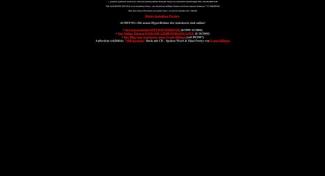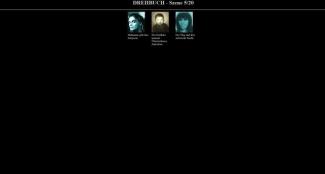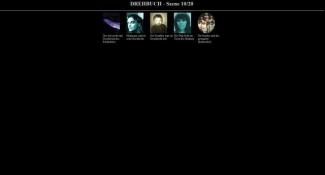Die Aaleskorte der Ölig ist ein Bilderdrama in 20 Szenen. Gespielt wird es von einem Schauspielerensemble aus zwei Schauspielern, einer Schauspielerin, einem Aal und dem Kinderchor. Der Leser soll die Regie übernehmen. Es geht um den Aalmythos, bzw. um ein Festmahl, bei dem der Aal verspeist werden soll. Mittels kurzer Regieanweisungen wie "Hohmann bereitet die Hinrichtung vor" oder "Die Ölig stellt sich ihrer Schuld" kann der zum Regisseur mutierte Leser/Zuschauer entscheiden, was er sehen will. "Je nach Regietalent versteht er früher oder später, worum es in der Geschichte geht. Zahlreiche Assoziationsmöglichkeiten und Vieldeutigkeiten machen Bezüge auch zwischen den verschiedenen Ebenen möglich und knüpfen das Netz der Geschichte allmählich immer enger", beschreibt Susanne Berkenheger die Möglichkeiten dieser Hyperfiktion. Nach dem Zusammenstellen der 20 Szenen werden diese geladen, dann bekommt der Leser/Zuschauer 20 Fotos mit kurzen Texten zu sehen, die wie eine Diaschau ablaufen. Am Ende jeder 'Neuverfilmung' winkt Hohmännchen, der Aalverkäufer, mit dem Aalkopf "goodbye".
Preisträger beim "Pegasus '98 - 3. ZEIT/IBM-Internet-Literaturwettbewerb" 1998.
Dirk Günther and Frank Klötgen’s German internet-based hypertext Die Aaleskorte der Ölig was originally created for the 1998 Pegasus Competition, organized by the German broadsheet Die Zeit, which awarded it the First Prize. For the first-time reader, Die Aaleskorte der Ölig may well fall under the category of cybertext as the programme appears to take over control of the ‘film’ once the reader has chosen their particular point(s) of view. Upon several readings, however, the reader gradually gains control over the underlying mechanisms. He or she becomes the director of a filmic story, whose perspectivity is in his or her hands. At the end of each ‘film’, or rather ‘commented slideshow’, the authors suggest revisiting the text from a different set of perspectives, as there are 6.9 billion possible versions available.
Die Aaleskorte der Ölig was a novelty because it places the reader in the position of a scriptwriter, who chooses the pictures and plot for a film. 20 scenes and points of view have to be selected prior to ‘watching’ the film, i.e. reading the plot fragments and observing the pictures. Every scene can be viewed from the point of view of the eel, the child-narrator, a woman called Ölig, the fishmonger Hohmann, or the neighbourhood children. The reader clicks his or her way through the plot. Only after a few run-throughs does the reader understand what the story is about. It describes the last minutes in the life of an eel, which is about to be beheaded by Hohmann, the fishmonger, and sold to Ölig. Depending on the chosen viewpoints, more or less information about each point of view will be revealed: of the eel, who tries to think of ways of escaping death, of Hohmann, who routinely goes through the process of killing the animal, of Ölig, who buys the fish because her doctor suggested it as a healthier alternative to meat, yet is horrified by its slipperiness and her own responsibility for its death, of the neighbourhood children standing by and frolicking whenever a fish has been caught, and, not least, by the child-narrator, the most obscure of all the characters, who tells the story from a neutral point of view. From him we learn about a somewhat perverse sexual relationship between the fishmonger and his female client, with the phallic, castrated (beheaded) eel representing, in a psychoanalytical reading, the male penis and the female clitoris. (The major themes employed by Günther and Klötgen are clearly reminiscent of Günther Grass’s novel The Tin Drum, with its never-growing child narrator and the maternal figure being traumatized by her husband’s phallic obsession with eels, which symbolize at once eros and thanatos, as they feed on cadavers, thus uniting death and sexual instinct.) After all, the Romans tellingly referred to the animal, which was considered the epitome of culinary (and, by the same token, oral sexual) pleasure, as rex voluptatis.
Die Aaleskorte der Ölig follows an aesthetics of disgust and revulsion. The story is deliberately kept banal, and the largely symbolically-employed, photographic images often display revolting scenes such as rotten food, blood, distorted faces, genitals, and slippery fish. The language is similarly mundane and colloquial. Upon repeated reading, however, a far more profound subtext is revealed. Continuing a psychoanalytical reading, the Ölig character represents the motif of the Electra complex. According to Simanowski (“Dirk Günthers und Frank Klötgens ‘Die Aaleskorte der Ölig’ oder: Der tiefe Sinn des Banalen”, 1999), the female protagonist sees in the eel the phallic desire for her lost father, symbolizing a postponed marriage. What seems more plausible to me, however, is her neurotic need to compensate for having been sexually abused as a child. Her inability to withdraw her order, along with her sadistic pleasure in watching the ‘dance’ of the fishmonger’s penis and the moribund eel, conveys her yet un-assimilated aggression towards and revenge for male sexual violence. Her fear of repeated abuse by the phallic eel becomes evident in her insistence upon company on her way home.
From a metamedial perspective, Die Aaleskorte der Ölig celebrates the re-incarnation of the linear in hypertext. In offering a plethora of different sequentially organized plots, it defies the usual craze surrounding antilinearity and thus remind the reader about hypertext’s actual reception-oriented quintessence: “What makes hypertext hypertext is not non-linearity but choice, the interaction of the reader to determine which of several or many paths through the available information is the one taken at a certain moment in time” (Charles Deemer: “What is Hypertext?”, 1994).
In addition to emphasizing the element of choice as pointed out by Deemer, Die Aaleskorte der Ölig lays bare the affinity between hypermedia and film, adding the element of reader control. The similarity with ‘Choose-your-own-adventure’ stories is intended. However, the authors undermine the ‘willing suspension of disbelief’ experienced in such projects by ways of disillusioning images, perverse imagery, and the banality of everyday life.
The entry has been adapted from Astrid Ensslin: Canonizing Hypertext: Explorations and Constructions. London: Continuum 2007, pp. 94-95.



